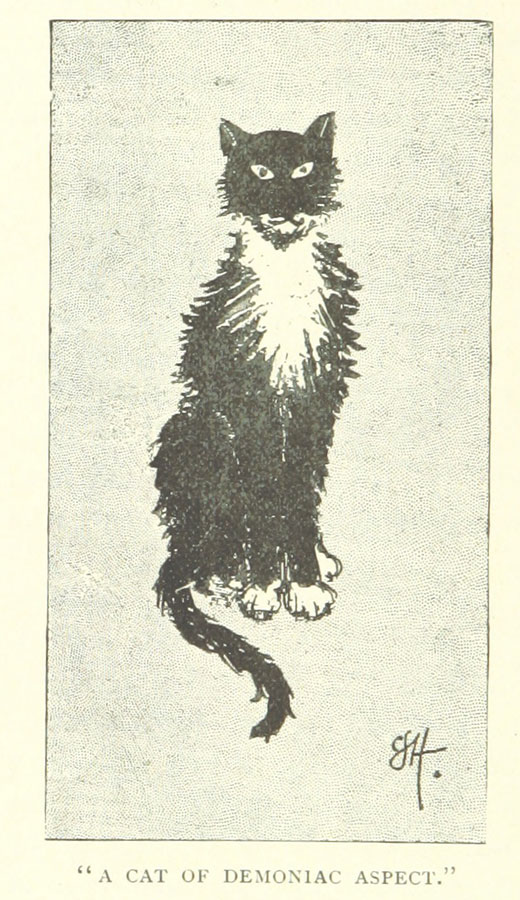Every year when October starts to get near, the Halloween decorations show up in stores. Along with pumpkins, witches, and ghosts, black cats have become a very popular symbol associated with Halloween.
So, why have black cats become so associated with Halloween?
History of Black Cats and Halloween
Prior to the Middle Ages, black cats weren’t seen a sign of witchcraft and dark magic. In Ancient Egypt, cats were venerated and became domesticated animals. The ability of cats to hunt rodents and protect stores of grains further ingratiated felines with the Egyptians.

As cats became domesticated, they spread into Europe. Cats were believed to have been brought by Greek and Phoenician traders into Europe about 3,000 years ago. With the arrival of cats came superstitions, both good and bad, about felines.
It wasn’t until the Middle Ages when the practice of fearing cats, especially black cats was started even though cats were commonly kept around the house, monasteries, convents, and churches,(Related: What is Being Afraid of Cats Called?)
On the eve of November 1, known as the Samhain, the Celts believed the veil between this world and the Otherworld was thin and spirits could pass into the world.

Samhain celebrated the end of the summer harvest and the midpoint between the autumn equinox and the winter solstice. Celts believed the change in seasons brought about conditions that allowed spirits to pass in their world. To appease these spirits, cats and other animals were sacrificed.
Cat Sìth, a fairy creature from Celtic mythology was believed to visit households around the Samhain. Described as a large black cat with a white spot on its chest, Cat Sith would curse houses that didn’t leave out a saucer of milk with cows whose milk had run dry.
This precursor to Halloween was the start of associating cats with October 31.

Demonizing Cats in the Middle Ages
The hostility towards cats in Europe was further cemented with the publication of Vox in Rama on June 13, 1233 by Pope Gregory IX. In banning heretics with this Bull, Pope Gregory IX associated cats with Satan and witchcraft. Cats were further vilified by Pope Innocent VIII who declared in his 1484 papal bull on witchcraft, “Summis Desiderantes Affectibus,” that cats were “the devil’s favorite animal and idol of all witches.”
Carrying Cultural Views on Black Cats by Early Settlers to the United States
The early settlers to the United States brought these negative views towards cats, black cats in particular, with them. During the times of the Witch Hunts in New England, these settlers firmly believed that witches could turn themselves into black cats. This superstition followed in the South with folktales like Black Cat’s Message and Wait Until Emmet Comes featured black cats who were demons and witches in disguise.

Current Superstitions About Black Cats
While the majority of people today have moved beyond think that cats are somehow diabolical or familiars of witches, some people still hold on to negative superstitions about black cats.
The most common superstition is that cats represent bad luck, especially in one crosses your path. This superstition is believed to be a holdover from Norman and Germanic folklore.
Dressing Up as a Black Cat Is a Popular Halloween Costume Choice
Blacks cats and Halloween is so popular that dressing up as a cat consistently ranks in the top ten most common Halloween costumes.
Why Won’t Some Shelters Let You Adopt a Black Cat Around Halloween?
It’s also a time when some animal shelters stop allowing black cats to be adopted until the month of November. The symbol of the black cat has become so welded to Halloween imagery that these shelters don’t want people just adopting these cats only to abandon them after the holiday has passed.
Halloween is a time when some shelters will stop adopting out black cats until after the holiday passes. With superstitions about black cats and their association with witches, shelters fear that people might adopt them in order to torture or abuse these cats.
While there is no actual proof that this type of evil behavior towards black cats actually happens, shelter prefer to err on the side of caution around Halloween with their bans on adopting black cats. The practice of halting black cat adoptions also prevents people who just want a black cat as Halloween decoration from adopting one.
Not all shelters ban the adoption of black cats around Halloween. There is a growing number taking the opposite approach and using this time of year to highlight black cats for adoption. Francis Battista from Best Friends Animal Society notes, “There is no evidence that adopting black cats around Halloween poses any greater risk to the pets than adopting them at any other time of the year.”
For these shelters, the greater risk is keeping black cats from finding their forever homes. Kentucky Humane Society Communications Director Andrea Blair, “They have the very best intentions, but the unintended consequences are the perpetuation of the myth – which leads to black cats spending even more time in shelters. Black cats often take longer to get adopted. The last thing we want to do is put up barriers that make it even harder for them to find loving homes.”
This article was first written on October 25, 2020 and has since been updated.
Read next: Vintage Halloween Postcards Featuring Black Cats
References
Black cat stigma. (2018, November 13). Animal Welfare League NSW. https://www.awlnsw.com.au/halloween-is-almost-here/
Engels, D. W. (1999). Classical cats: the rise and fall of the sacred cat. Psychology Press.
Foreman, A. (2018, October 18). The dark lore of Black cats. Wall Street Journal. https://www.wsj.com/articles/the-dark-lore-of-black-cats-1539881906
Valade, J. (2017). Who’s afraid of a big black cat? HumanePro. https://humanepro.org/magazine/articles/whos-afraid-big-black-cat
Related
- Black Cats
- Do Black Cats Like to Lie on Black Things?
- Why are Some Cats All White?
- Things to Know About Orange Tabbies







